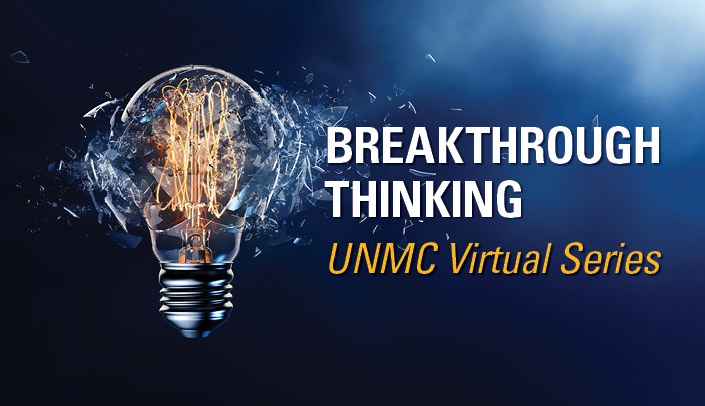What if we dared to do something with our ideas?
That was the question Julie Lenzer, the new chief innovation officer for the Advanced Regenerative Manufacturing Institute, posed to the UNMC community during last week’s Breakthrough Thinking presentation titled "What if? The Art of Possibility Thinking."
UNMC’s Breakthrough Thinking series, designed to challenge and inspire out-of-the-box thinking, features a variety of speakers and topics throughout the year.
Watch the Breakthrough Thinking presentation online.
"Challenging the status quo means we can make the impossible possible," said Lenzer, who is founding director for the newly launched Quantum Startup Foundry and most recently served as chief innovation officer at the University of Maryland.
Possibility thinking is a mindset that drives innovation, she said. It conveys a "yes, and" focus, a "how can we?" attitude and a "what if" outlook that helps send innovative ideas past real or perceived barriers.
"What if Dr. Fleming put the Petri dish back?" Lenzer said, highlighting how accidents aren’t necessarily bad. In 1928, Dr. Alexander Fleming discovered penicillin after he left an uncovered Petri dish near an open window during his two-week vacation. Upon return, he found mold had developed on an accidently contaminated staphylococcus culture plate, and the culture prevented the growth of staphylococci.
"What if failures could lead to success?" she said, recounting the accidental invention of the pacemaker. The engineer, she said, was building an oscillator to record heart sounds when he accidentally installed a resistor with the wrong resistance, and it began to give off a steady electrical pulse.
As Rear Admiral Grace Hopper once said: "The most dangerous phrase in the language is, ‘We’ve always done it this way. ’"
Lenzer encouraged the audience to get out of its comfort zone, take calculated risks, accept failure as a possibility and share ideas — even the "crazy" ones — knowing it could be a catalyst for someone else’s idea and "might just lead to the next great vaccine or therapeutic."
The audience also heard Sonia Marciano, PhD, clinical professor at the New York University Stern School of Management, discuss strategy and enterprise value and how organizations can maximize the impact of their strategy.
During discussions on where to invest time and resources, Dr. Marciano used the example of a student seeking an A in a class, noting they can maximize their time and effort by knowing the weight (importance) and the amount of (perceived) variance by customers (teacher).
Then, using Steinway & Sons as a case study, she discussed factors that help assess a good strategy. These include taking a risk and putting skin in the game, creating path-dependent innovations so competitors cannot profitably match or leapfrog the company, building credibility so consumers find shopping around confusing and scary, minimizing profit and loss so shopping around has low potential upside and creating a network where suppliers benefit in working with you.
"Quality is an arms race, but not a strategy," Dr. Marciano said. "Calibrate your use of time and money to get a good-great return on investment."
